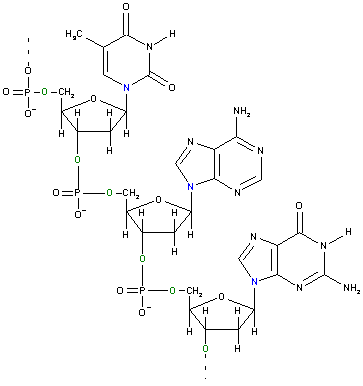If the carbon atoms in positions three and five are esterified with phosphates, we can link nucleotides together to form polynucleotides. Shown below is a short segment of a (deoxy) polynucleotide with the bases thymine, adenine, and guanine.

We can describe the structure of polynucleotides in much the same way we described the structure of proteins.
- The primary structure is the order in which the bases occur. The convention is to list them left to right from the 5' end to the 3' end, though when drawing two strands it is necessary to specify the ends of both strands. The above figure has the primary structure 5'-TAG-3'.
- The backbone consists of the phosphate-sugar chain that runs the length of the polynucleotide.
- Finally, the secondary structure is the three-dimensional structure of the polynucleotide strand or strands. For DNA the most important secondary structure consists of a double helix (two strands) held together by hydrogen bonding between the bases.
All of these aspects of the structure of DNA are illustrated in the next page...